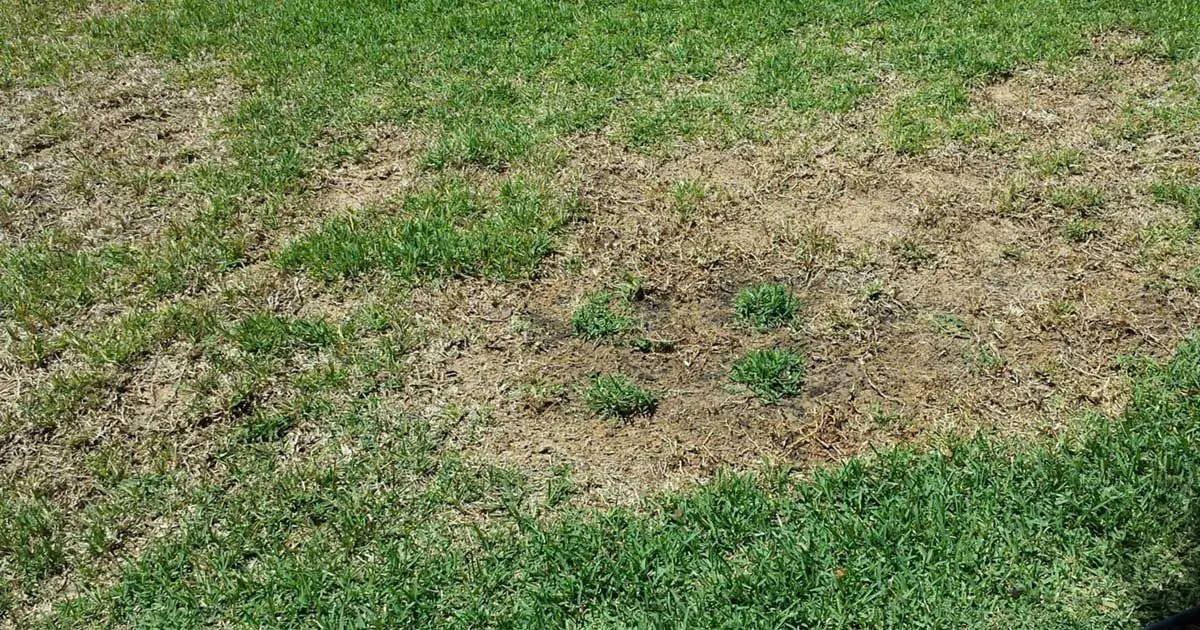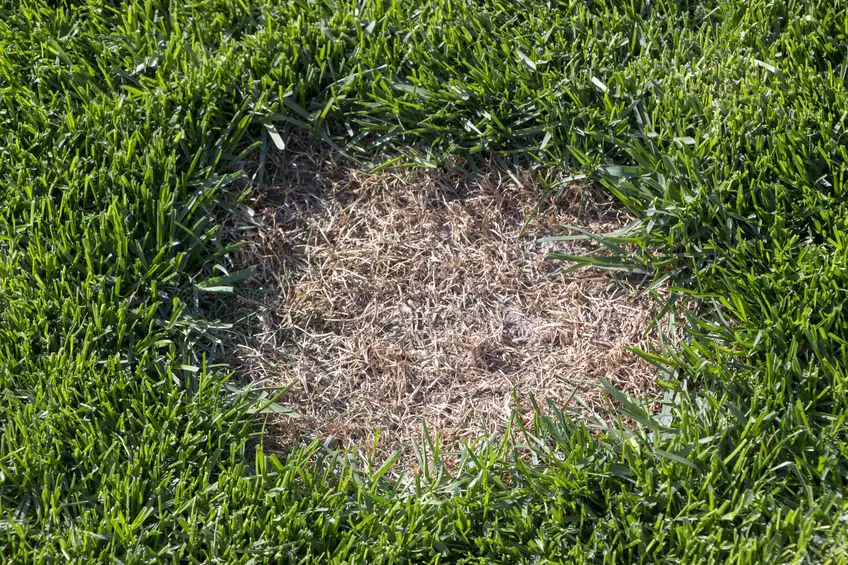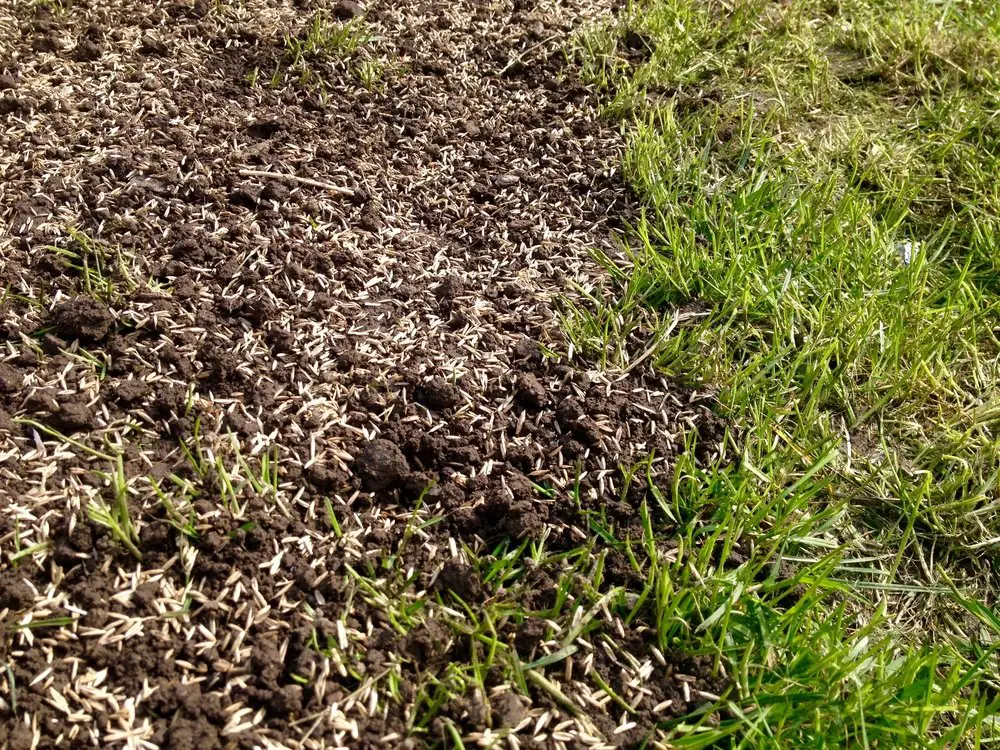Plant Food For My Lawn & Soil Fertility
Soil fertility is of importance, so feed the entire lawn with organic lawn fertilizer every couple of weeks.
A healthy lawn growing from grass seed on healthy soil will minimize the chances of clover growing.
In early spring, you can apply different fertilizing materials such as earthworm castings, bone meal, liquid seaweed fertilizer, guano, or cow manure to your lawn to boost its growth.
This enables the grass to suppress the weeds.
Any standard fertilizer also contains some nitrogen. As mentioned earlier, nitrogen will aid in reducing the growth and spreading of clover.
How To Repair Bare Spots
The cause, of course, determines the cure.
If the bare spots are dog spots, Churchill suggests flushing the area with water to move excess salt through the soil. Afterward, prepare the soil for repair by scratching it up, even adding in some new soil to make the area level with the rest of the lawn.
If the cause of the bare spot is disease or other growth issues, Churchill says to scruff up the straw or dust from the dead area, add new soil and mix into the existing soil. Then overseed the area and water in as you would with new grass seed. If the area is bigger, you may want to consider sprigging or sodding to fill the bare spots. Generally, reseeding the spots will do.
Once you repaired the bare spots, Churchill says you shouldnt need to change maintenance practices, other than spot-irrigating the areas that were reseeded, sprigged or sodded.
Do You Have To Get Rid Of Old Sod Before Laying New Sod
It is essential that you remove existing grass before laying new sod. Laying new sod on top of an established yard will result in the following:
- New sod will not take root and may die.
- Old grass and weeds will invade new sod.
- New sod will raise the level of your yard about 1 inch, resulting in poor drainage and flooding on paved areas
Make sure you fully remove your existing lawn before laying new sod to ensure you end up with a pristine new lawn.
Recommended Reading: How To Kill Wild Violet Weeds In Lawn
Keep Soil Moist Until Seeds Sprout
Seeds that dry out will die. Once this occurs no matter how much you water them you will have to replant. Depending upon your soil conditions and the weather, you may have to water the seeds several times a day. Knowing that this is not always possible aim for a minimum of two times per day.
- Keep the soil moist, but not so wet that it is soggy or with water collected on the surface. This condition will actually kill your seeds as well.
- Expect to see seedlings within 4-7 days depending on weather conditions and seed type. You grass should be ready to mow once they reach around 4″ in height or in about 2 weeks.
Getting Rid Of Brown Spots On Your Lawn

- BlogGetting Rid of Brown Spots on Your Lawn
Does your otherwise beautiful property have mysterious brown patches that wont disappear, no matter how much you try to water or fertilize them?
Curb appeal can make or break a first impression of your home or business, and a healthy, well-maintained lawn can impress visitors and increase your property value. We understand how frustrating a spotty lawn can be. Luckily for you, were here to help you banish those brown spots so your lawn can make the best impression on the block.
Discover what causes brown spots in the lawn, how to fix them and how to prevent their return with proven tips from our lawn maintenance experts.
Recommended Reading: How To Estimate Lawn Mowing Jobs
How Do You Bring A Dead Lawn Back To Life
How To Get Rid Of Brown Patch
Among others, one of the best solutions has something to do with watering. Especially during the summer, you need to water regularly to prevent the lawn from getting dry. On the other hand, you should also prevent over-watering. This will make the surface wet while the soil remains dry, increasing the risk of a disease that can lead to brown patch.
Detaching is another solution that will be effective for brown patches. If there is heavy thatch or if it is more than half an inch, you have to act. This is because it can be a breeding ground for fungi, aside from the fact that it can also be a barrier for the absorption of the nutrients from water that the roots need. Aerating the lawn can be a big help.
It will also be good if you can run a quick test of the soil. There are kits that are commercially available, which will make it easy to determine the quality of the soil. This will help you to determine which fertilizer is best and to prevent brown patches. For instance, if the pH level is more than 6, you need to use nitrogen-based fertilizer at the start of spring.
Especially During the Summer, You Need to Water Regularly to Prevent the Lawn from Getting Dry
Also Check: Does Peat Moss Help Grass Grow
How Do I Fix Dead White Patches In My Lawn
I’m in the process of trying to repair this lawn and I’m looking for advice on how best to go about it. As you can see from the attached I have a lot of white patches, a problem with dandelions and I’ve also found the following grub whilst attempting to manually get rid of some of the dandelions. I’m not sure if the dead grass is being caused by this grub or just poor maintenance generally. Is this dead grass thatch that needs to be removed or just dormant grass? Sorry for the plethora of questions just would like some advice on what to do next. I’m in the UK and as yet have not fertilised or seeded or dethatched. there has been two cuts done thus far. and mower set highest setting. I’m manually removing weeds.
So no presents for you under the plastic then! I’m glad really – that larvae you found could be the larvae of a moth or butterfly because its not immediately recognisable as a leatherjacket, but might have been. What’s odd is you found it actually under the lawn, and that isn’t at all typical of moth larvae.
If any moss that’s present turns black, rake it out, and if that leaves bald patches that are quite noticeable, you may need to reseed those patches, but that can’t be attempted until six weeks after the chemical treatments have been applied. At this point, you could scarify the lawn – it will make it look pretty awful, but it should recover quickly.
How To Remove Dead Grass After Roundup
Once youve killed grass and weeds with Roundup, there are several methods that can be used to get rid of the dead, brown vegetation. They are:
- Remove the dead lawn with a sod cutter.
- Mow dead grass as low to the ground as possible, then use a dethatcher or power rake to remove any remaining material.
- Use a string trimmer or weed eater to cut dead grass off at ground level.
- After mowing grass low, till remaining dead grass into the soil.
- In small areas, use a shovel to cut away dead grass, removing the top 24 inches of soil to get rid of grass roots.
Some methods are best for removing dead grass from an entire yard, while others excel when you are getting rid of patches of dead grass, or dead grass growing through concrete. Read on for more information on how and when to employ each of these methods.
You May Like: How To Change Oil In Craftsman Lawn Mower
Weed Control & Prevention
As an extra preventative measure against weeds, make sure to use a weed killer. I recommend using a starter fertilizer + weed preventer .
You have to be careful about what you use, because some pre-emergent weed preventers will prevent your grass seed from germinating.
Once your grass is growing, eliminate weeds early by using a post-emergent weed killer. New grass cant withstand a weed killer until its fully grown in, usually after youve mown it 3 or 4 times. After that, its safe to use.
To spot-treat for established weeds, I recommend using the herbicide Tenacity. Theres a video and how-to included in my article on eliminating lawn weeds.
What Is Brown Patch Fungus
Brown patch fungus, sometimes referred to as large patch disease, is a lawn disease caused by a single species of fungus called the Rhizoctonia solani fungus. Its a foliar disease, meaning that it damages the blades of grass but doesnt affect the crown of the grass plant or its root system. Brown patch fungus often occurs during mid to late summer as it thrives in the heat and humidity of these seasons. While brown patch disease isnt commonly seen on lawns in arid regions such as Southern California and the Mountain States, it affects lawns throughout the rest of the United States.
Also Check: Craftsman Push Mower Oil Change
How To Repair Bare Spots In Lawns
Learning how to fix bare spots in lawn spaces is an essential part of lawn maintenance. The best method for grass spot repair is to overseed with new grass seed in the affected area. Overseeding, or planting new grass seed, allows for a healthy new start and can result in a virtually undetectable repair.
The best time to sow seeds for lawn patch repair depends on the type of grass you have. Youll want to match the type of grass seed to what is already growing. Cool season grasses do best when planted in late summer to early fall. Warm season grasses perform best when the seed is sown in spring or early summer.
If youre not sure what seed to use, give your local extension office a call. They can identify the perfect grass for your area and help figure out what types of grass will give you the quickest grass spot repair solution.
Inspection For Brown Patch Fungus Disease

When inspecting your lawn for Brown patches, you have to carry out the following steps:
- Check the grass for brown or gray lesions and curling
- If you check early in the morning, you may see white fungal threads throughout the Afflicted areas.
- Check your lawn for any rapidly yellowing patches.
- The brown patch fungus is known to infect all types of cool-season grasses like fescue.
- Certain types of warm-season grasses, like st. Augustine grass, a brown patch will thrive in the hot humid weather conditions, like poor aeration, and over-watering pour water could make turf.
- Compacted soil will also cause grass and make turf more susceptible to disease developments.
- Check for heavily shaded parts of your lawn or near areas that have poor water drainage for signs of disease.
- Take note of these conditions when you find them, as theyll direct where to focus.
Recommended Reading: Where Are Cub Cadet Tractors Made
The Least You Need To Know
There is no chemical, even saltwater, that you can put in your soil to kill hookworms that wont also kill your plants or your lawn.
However, cold snaps during winter and really high heat of over 113 degrees Fahrenheit will kill them.
Pick up animal droppings daily so that any hookworm eggs in them will not have a chance of hatching.
Place And Water The Patch
Place the sod patch into the excavated area, and compress it into the ground by walking on it repeatedly. Water immediately, and repeat watering two or three times a day for several days, until the sod patch is bonded and is beginning to grow actively.
Within no more than a week or two, your sod patch should be seamless and indistinguishable from the rest of your lawn. Do not be surprised if it is a slightly different color at first this will disappear soon.
Also Check: Where Are Cub Cadet Lawn Mowers Made
How To To Get Rid Of Brown Patch Fungus On Grass
Many conditions can cause patches of brown, dead grass on your lawn, but only one gets the official name brown patch. Brown patch disease is a condition caused by a single species of fungus, Rhizoctonia, that often occurs in mid- to late-summer when the weather is hot and humid.
Sunday Patch Kits Make It Even Easier
The Patch Pro grass seed blend is optimized to work in most lawn conditions, and to grow in quickly. Our organic mulch helps to retain needed moisture and provide nutrients to the new grass.
Sunday Patch Kits are available to add on to your lawn plan at check out or from your plan account page at anytime.
Read Also: How To Estimate Lawn Mowing Jobs
A Lush Lawn Can Still Be Prone To Bare Spots We Take A Look At The Causes How To Repair Them And Cover The Bare Spots
You finally have your lawn just how you want it green and lush and thriving. Then, all of a sudden, a bare spot appears. What to do? To find out why bare spots occur, and how to fix them to return your lawn to its splendor, we checked in with Joe Churchill, senior turf specialist with Reinders, Inc. to share his insights and tips.
Plant At The Right Time Of Year
The goal is to get the roots established before environmental conditions become too harsh for the baby grass to survive. The best time to repair bare patches is when the grass is actively growing, says Waltz. That depends on where you live. Warm season grasses grow during the warm times of year, which is about May to mid-September. Cool season grasses grow during the cooler times of year until the soil freezes, which is roughly December to February. If youre not sure what you have, talk to your local university coop extension service. Both seed and sod are good options for patching.
Don’t Miss: Aerator Rental Lowes
Remove All The Grass In The Problem Spot
Dig up and remove the grass in the problem area. I find it easiest to wet the soil briefly first to make the soil easier to work with. Outline the problem area with a flat spade shovel. Enlarge the area slightly to make work easier and to ensure entire problem area is removed.
Using the same flat spade shovel remove the top layer of remaining turf and soil. Work from the middle out until the shovel hits the deep edge you created when making the border.
Treating Sandy Or Clay Patches

Your yard may have sandy or clay spots where plants dont grow. Usually, hookworm larvae need plants in the ground to help keep the soil moist enough to thrive in.
However, sandy or clay spots can be moist enough for hookworms, even if no plants are present.
Treat these areas with boric acid. Use ten pounds every 100 square feet. Spread a fine layer on the top so you can see it.
Take a rake and work it into the soil. Make sure not to water these areas.
Its best to treat when the forecast calls for dry weather or the wet soil may dilute the boric acid too much.
Recommended Reading: Battery Lawn Edger
Brown Patch Lawn Disease 101
Brown patch, though common in Central and Southern Maryland, doesnt always quickly reveal its existence. In fact, the first signs of trouble can resemble other types of lawn problems like drought, other diseases, or even other types of damage from insect or nutrient deficiencies. Thats why learning how to get rid of brown patch fungus means learning all you can about the disease itself.
Thatch And Brown Patches
Problem: Thatch is actually a tightly intermingled layer of dead and decaying vegetationan unhealthy build-up of organic matter that can cause brown patches in a lawnindicating a pH imbalance. You may notice a spongy feeling when you walk across the lawn. Thatch is actually more common in lawns that receive a lot of maintenance than in lawns receiving less care. Thatch is a problem especially in lawns previously treated with chemicals where the grasss natural ability to decay has been destroyed. Dry thatch repels water, while wet thatch invites fungal diseases.
Solutions: The best control is raising the lawn soils pH level. One way to do this is to rent a power rake, also called a dethatching machine , which uses rigid wire tines or steel blades that slice through the thatch to the soil surface, tearing and pulling up the thatch. The best time to de-thatch is in late spring. Dont do it during midsummer, when the lawn may be stressed, or when the lawn is wet. Hand raking is less harsh but can be impractical and back-breaking work for large lawns. Molasses diluted with hot water and sprayed on the lawn can help stimulate natural organisms to eat the thatch layer.
Dethatching with a power rake can be very destructive. Because of this, it may be best to aerate lawns that have thick thatch layers.
Aerification can help reduce thatch that is more than ¾ thick. Aerate the lawn annually and reduce your water and fertilization rates to reduce thatch buildup.
Recommended Reading: How To Clean Push Mower Carburetor
